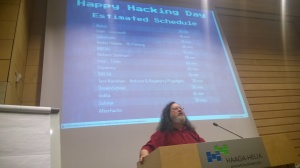Yesterday, Feb 11th, was the day of the 2nd Annual Happy Hacking Day at HAAGA-HELIA University of Applied Sciences.
The word ‘hacking’ has a notorious sound to it. That is due to the early days, when so-called black hat hackers broke into computer systems with malice and forethought, and caused widespread havoc (today we also have white hat hackers, who are good guys, and grey hat hackers of whom we are not so sure).
But you need to remember, that Wikipedia states this:
A hacker is someone who loves to program or who enjoys playful cleverness, or a combination of the two. The act of engaging in activities (such as programming or other media) in a spirit of playfulness and exploration is termed hacking. However the defining characteristic of a hacker is not the activities performed themselves (e.g. programming), but the manner in which it is done: Hacking entails some form of excellence, for example exploring the limits of what is possible, thereby doing something exciting and meaningful. Activities of playful cleverness can be said to have “hack value” and are termed hacks (examples include pranks at MIT intended to demonstrate technical aptitude and cleverness).
So, the hacking as seen yesterday definitely falls into the class described by Wikipedia.
We also had a world class keynote speaker, mr Richard Stallman, whose lecture is always an experience, and from which one cannot come out without being deep in thought about free software. Stallman advocates the idea that if software is not entirely free for you to take into use, see the source code, edit the source code if you need, and then redistribute back into the society, the software is infringing on your personal freedom. This was the first time I have heard Stallman speak, and it was very enlightening.
Besides this experience, we had many other enlightening speakers from companies such as Intel, Solinor, Solita, Cybercom (you can see all of them presenters on the Happy Hacking Day website). Presentations will be made available on that site too, very soon. The auditorium was almost filled to capacity, and presentations were followed by questions and discussion. The HAAGA-HELIA IT programme director, Harri Palviainen, opened the event.
There was also a display of hacks available at the lobby of the Pasila Campus. We were treated to a Russian Nuclear Power Station simulator, which was built with a genuine Soviet look and feel (at some point the simulator nearly went critical with associated warning horns and a thick plume of smoke emanating from the system). The system is built by the wonderful Helsinki Hacklab, which provides prospective hackers with a location, tools, and comrades in soldering.
Another excellent demo we saw was the RuuviTracker open source GPS positioning (and much more) device project. I have to say that even if I am not an experienced tinkerer, I like seeing systems that have been cobbled together with bits of wire and hot glue, and which work like a dream anyway.
The Espoo Christian School brought us their soon-to-be-launched satellite project. This device will be carried to the International Space Station to study the growth of spores in zero gravity.
My own presentation this time had two parts, first how to create graffiti and wallpaper on a wall using Blender Cycles, and then on the Minifactory 3D printer that we have acquired for the University. I think it went well enough and people got their money’s worth (I must stress it was a free event). The current Blender course has 67 participants, and after that we have a total of 150 people on campus who have taken the course. I think it is time to try and launch a Blender Club to the converts.
I also brought the MiniFactory from Malmi to Pasila and installed it in one of the rooms adjacent to the lobby, and there were about 70 people who came in to see it in operation. For many it was the first time they had seen a 3D printer run, or held a printed piece in their hand. This is essential in raising awareness of the fact that we have the device, and that students and faculty alike can start thinking of ways for its use.
What I like about this event is that it is mainly run by students. Tuomo Ryynänen, one of our senior lecturers, is of course a key driving force behind the event, but the student team did a really great job keeping the show going.
As a parting shot, I offer you this picture of Richard Stallman in his avatar of St iGNUcius with his halo (a hard drive disk in a previous incarnation), a saint in the Church of EMACS (a word processor of a most worthy history) giving his blessing to the congregation of free software enthusiasts:
See you next year!
![]()

![WP_20140211_001[1]](http://heikkihietala.files.wordpress.com/2014/02/wp_20140211_0011.jpg?w=300&resize=300%2C168)
![WP_20140211_003[1]](http://heikkihietala.files.wordpress.com/2014/02/wp_20140211_0031.jpg?w=300&resize=300%2C168)
![WP_20140211_005[1]](http://heikkihietala.files.wordpress.com/2014/02/wp_20140211_0051.jpg?w=300&resize=300%2C168)
![WP_20140211_023[1]](http://heikkihietala.files.wordpress.com/2014/02/wp_20140211_0231.jpg?w=300&resize=300%2C168)
![WP_20140211_027[1]](http://heikkihietala.files.wordpress.com/2014/02/wp_20140211_0271.jpg?w=300&resize=300%2C168)
Kiitos Heikki! Vähän videota: